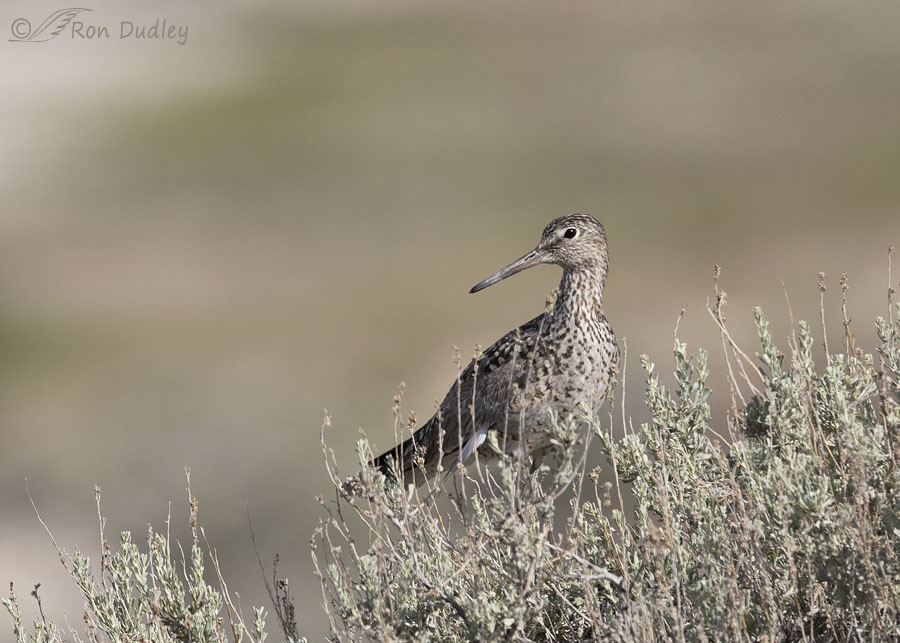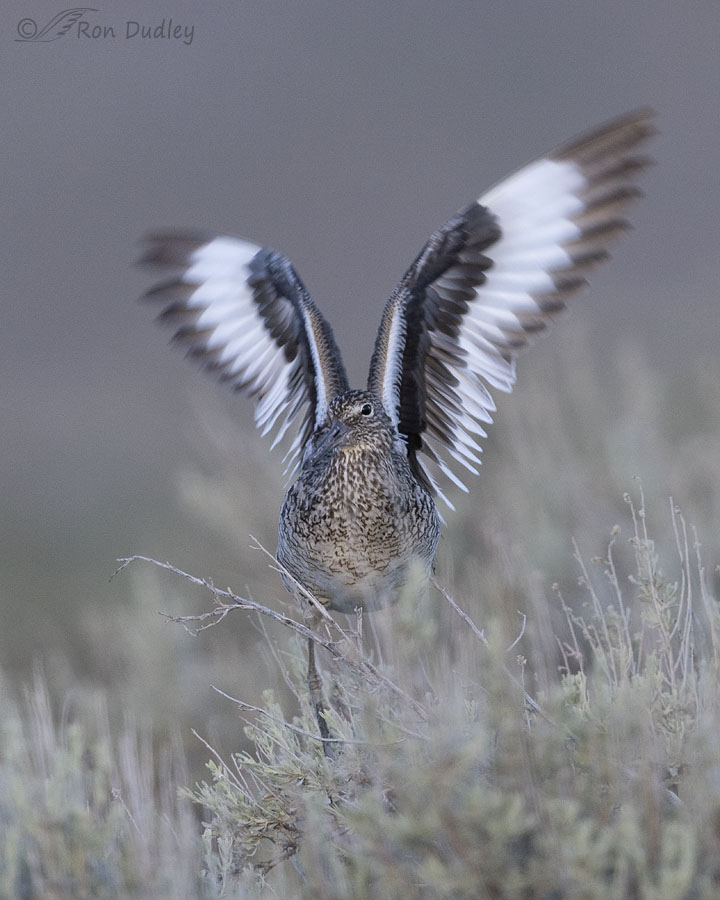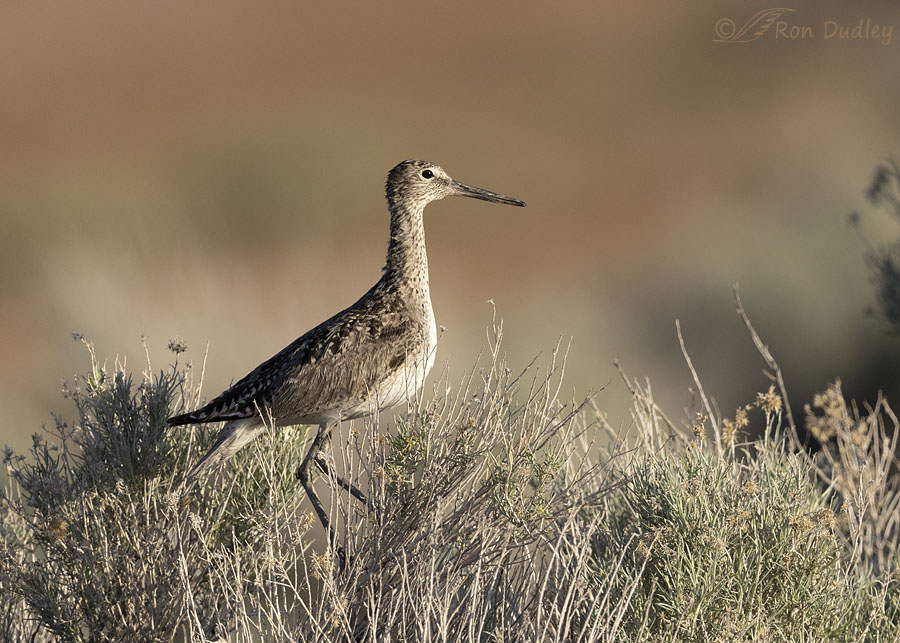Including a video clip, taken yesterday on Antelope Island.
In the past, many of my blog followers living near the Atlantic Seaboard or Gulf Coast have mentioned how strange it seems to them when I post photos of Willets taken here in the high desert of Utah. Willets actually breed on Antelope Island where their normally rather docile behavior transforms into competitive and aggressive flight displays, aerial dogfights, aerial pursuit, ground fights, swooping on opponents, head-bobbing and loud vocalizations.
And sagebrush. They love to perch on sagebrush. They’re highly territorial while breeding so in this habitat sagebrush provides a convenient and elevated perch from which they can guard and defend their territory. Apparently it seems incongruous for folks in coastal areas to associate Willets with sagebrush but around here, and to me, they seem to go together naturally.
Yesterday was a Willet kind of day on Antelope Island. I didn’t get any photos of them that were standouts but today I thought I’d use some of them to document their presence on the island, their affinity for sagebrush perches and their breeding behavior.

1/5000, f/6.3, ISO 500, Canon R5, Canon EF500mm f/4L IS II USM + 1.4 tc, not baited, set up or called in
Sagebrush isn’t an ideal perch for the bird photographer because its abundant vertical stems tend to block a clear view of any bird perched on it. But this time of year, if I’m on the lookout for Willets, that’s where I’ll usually find them. When I pulled up on this one it was obviously interacting aggressively with other nearby Willets that I could hear but not see. I was hoping to get some interesting behavioral shots but that didn’t happen.
I’ve always thought of Willets as Cinderella birds. While perched or on the ground their garden variety, brownish coloration is unexceptional.

1/1250, f/5.6, ISO 1600, Canon R5, Canon EF500mm f/4L IS II USM + 1.4 tc, not baited, set up or called in
But that all changes the instant they raise their wings, when they reveal a striking and unusually broad white wing-stripe that runs across their primaries and secondaries, bordered in black.
I found this Willet very soon after sunrise when there was a low band of clouds in front of the sun. The light was exceptionally dim so I had insufficient shutter speed and depth of field for the situation, even at ISO 1600. But I still think it’s an interesting photo, especially for the wing reveal.
This bird wasn’t taking off, it had just lost its balance on its perch. For fairly large birds like Willets sagebrush doesn’t provide a very stable perching platform so they often struggle to keep their balance, as you’ll see if you open the link to a video I took yesterday, I’ll post that link below.

1/4000, f/5.6, ISO 800, Canon R5, Canon EF500mm f/4L IS II USM + 1.4 tc, not baited, set up or called in
Still photos, as opposed to videos, can be highly misleading when it comes to behaviors. This may look like an alert but fairly calm and tranquil bird in a peaceful situation but reality was far different from that. This Willet, most likely a male, was acting and sounding aggressive to other nearby Willets and having a hard time balancing on the sagebrush at the same time. I shot a short video of his behavior if you’re interested. If you watch the clip be sure to have your sound turned up from the very beginning.
It’s an amateurish video that needs editing but I think it’s worth watching. I promise, when I get some other priorities out of the way I’m going to learn how to edit my videos!
Ron


I’m a video shooter and I have found shooting from car windows (which I’m assuming you do) is very difficult to control without something to stabilize the camera. If you don’t already, you might bring along a small beanbag to rest the camera on while shooting. If your window has the room for that, you’ll find your results more stable. I love seeing the action, so thank you for including video at times.
I love Willets; they nest here along our beach. They are very(!) vocal, and their calls are one of the first bird calls I learned. I hope you do more videos in the future – great way to show behaviors.
They’re “very vocal” indeed, Nancy. Especially during the breeding season, as you obviously know.
The sagebrush is a totally challenging platform. Kudos to the willet for not doing several face plants (though there were some close calls). And thank you for yet more fascinating behaviour (and a beautiful bird) that I will not see for myself.
You’re very welcome, EC.
Thx for including the video! Quite a balancing act staying on the Sagebrush. And the wonderful surprise of color when the wings are raised! Wow!
Thanks, Kathleen.
Sorry I missed seeing them on the island when I was there (a week ago today already!). But it was *much* later in the morning than when you were there so no surprise there. Willets are such interesting-looking and sounding-birds, and rather surprising they’d find sagebrush to be a reliable perch (since it obviously isn’t). Love his efforts to keep balance, though. And besides the Willet, I loved hearing the Western Meadowlark in the background of your video!
Chris, it’s funny how the Willets seem to disappear later in the morning and for most of the rest of the day. But early, in some areas, there’s lots of them. Right now anyway, but it won’t last long.
I wondered if anyone would mention (or even notice) the meadowlark.
The Meadowlark’s song is (IMHO) one of the best in the world, and I thoroughly enjoyed listening to them while I was on the island, and also at Ogden Nature Center. They were my dad’s favorite bird — he grew up on Saskatchewan prairie, often talked about them — so a sweet remembrance for me!
Location. Location. Location. The video was comical, yet also a little sad — ’tis not easy to patrol one’s territory. Those wings are really something too.
Marty, the clip may have looked comical to us but that Willet (and the others you heard) were deadly serious.
I’d have to agree with the other coasters that this bird seems a stranger in a strange land. The video is comical; appears to be bothered by the stems poking up. That and trying to stay balanced makes one think that evolution has a sense of humor.
I like your Cinderella analogy, although those would be some weird glass slippers.
“The video is comical”
Lyle, I wish I’d started videoing this bird about 10 seconds earlier. His calling was persistent and loud and you’d be able to hear the other calling Willets even better.
I know some people find your location odd for shorebirds. But for me, a Willet not in sagebrush country is definitely out of place. There are plenty of shorebirds along our coast or passing through the valley, but I go east of the mountains, not to the coast to see Willets. They are very striking birds as they land on a perch and raise those wings. Thanks for sharing them.
Dan, I’ve always wondered why they have that elevated wing behavior after they’ve landed. It’s neat to see (and photograph) but I wonder if it has a purpose.
Love the shot of the back swept wings! Also, great to see some video of behaviors most people don’t get to see in person.
Good to know you liked seeing the behaviors, Brett. Thanks.
Neat! The video sure does give a different perspective as does the photo of the raised wings. Sure different then what appears to be a non-discript bird going about it’s business
Thank you, Judy.
I like that ‘Cinderella” analogy for the wings-up analogy. When I watched the video, I thought I was seeing agitated stomping –after reading one of the
comments, I guessed maybe it was just difficulty staying upright on the sagebrush ? Or do they also do that fancy footwork on solid ground ?
Kris, I’ve only seen it when they’re trying to balance on their perch, usually sagebrush. I’ve never seen it when they’re on the ground.
Nice video. They really do have trouble standing on that sagebrush.
They sure do. Regularly.
What an amazing difference between the video and the still shot. In the still shot you would assume just another calm day in the sagebrush. I have only seen them a few times here in small numbers, and mostly busy foraging in shallow water. I do really appreciate having that chance to occasionally see them. Good post Ron – thanks.
I’m glad you enjoyed it, Everett. Thanks.
Love that little video, Ron. We see Willets here at the central coast, but not acting like this!
Good! Thanks Dan.